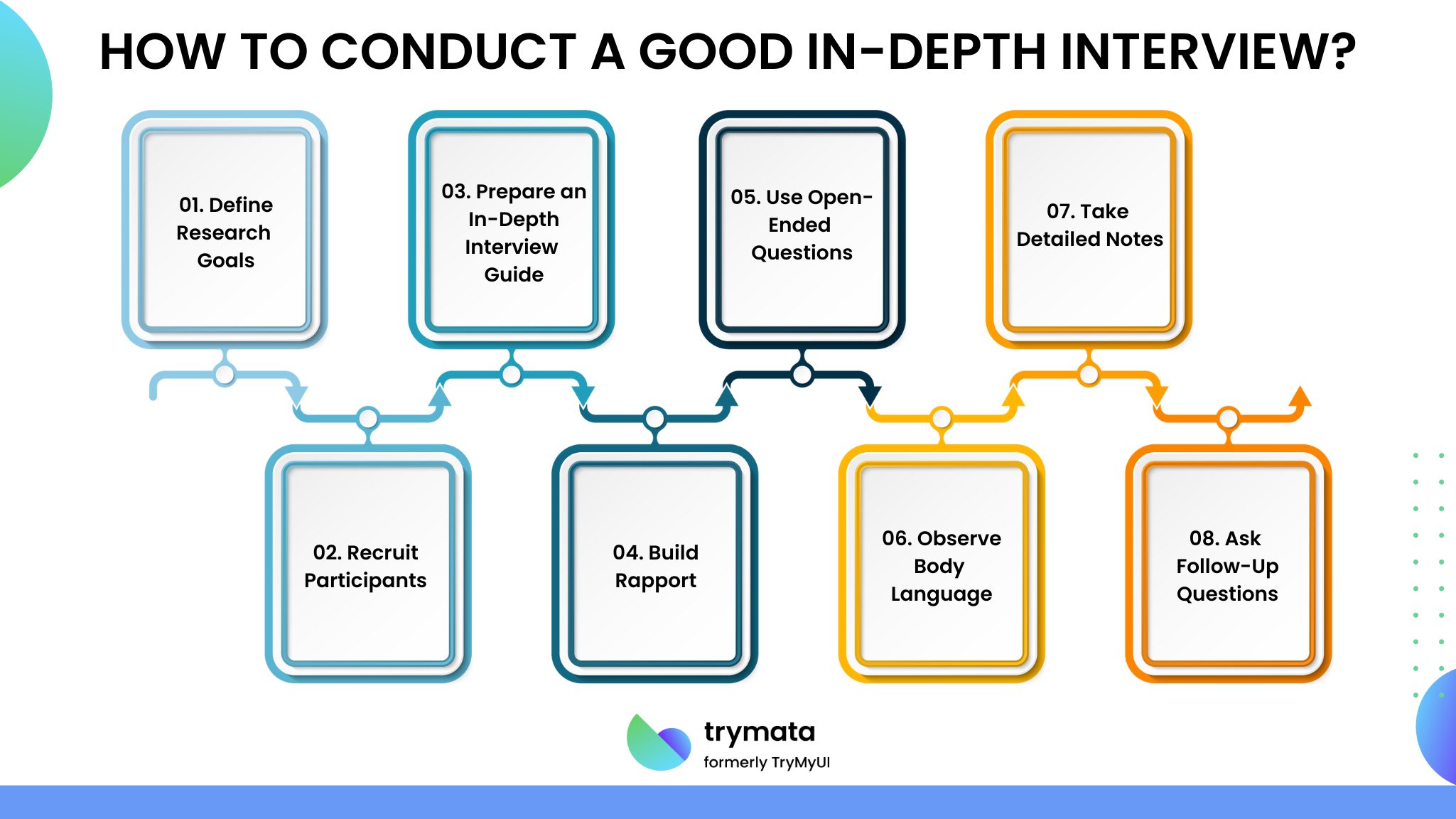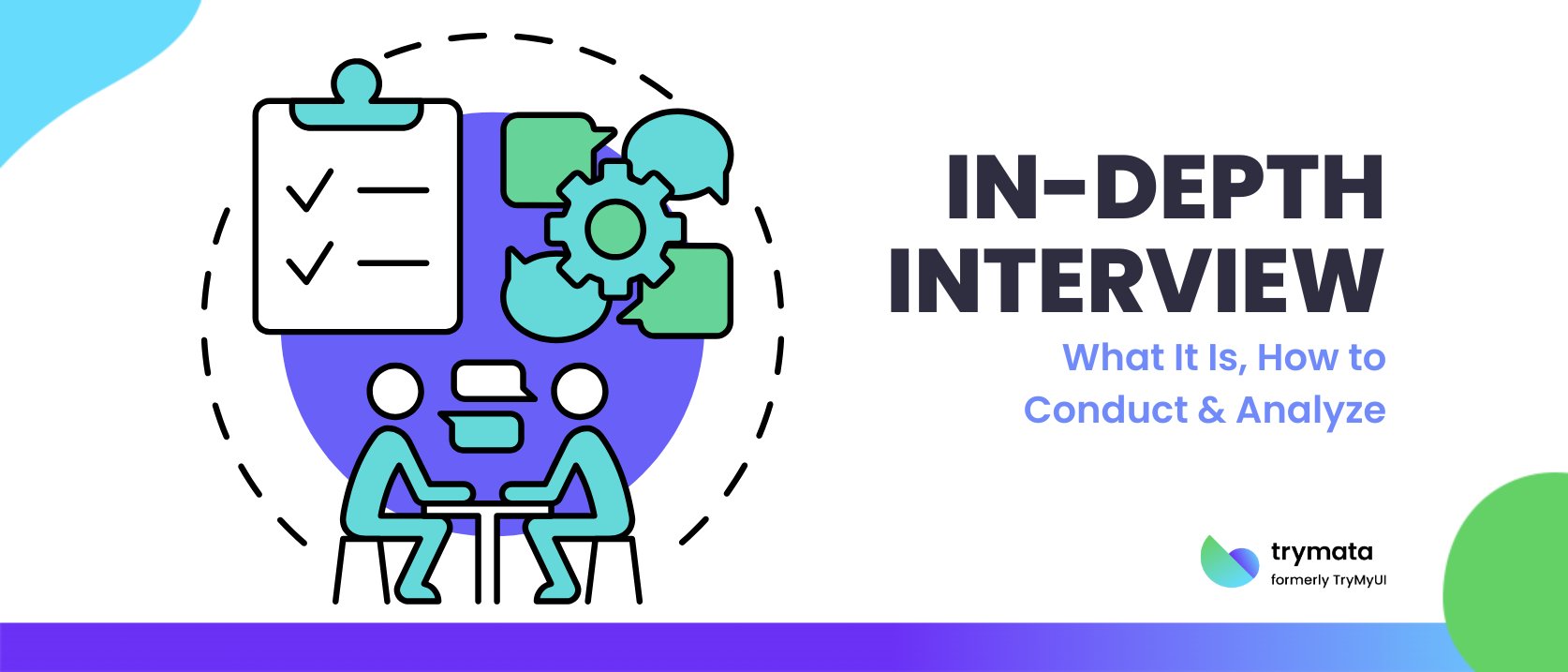In-depth interview is a robust qualitative research method that allows researchers to interact one-on-one with participants and capture rich qualitative data beyond surface-level insights. Unlike focus groups or online surveys, these interviews deeply explore user experiences, offering detailed responses highlighting pain points, motivations, and behaviors.
Conducting user interviews, whether used in usability testing, market research, or product development, helps businesses collect data that leads to better insights and more informed decision-making.
This blog explores the essentials of in-depth interviews, from their characteristics to effective analysis techniques.
What is an In-Depth Interview?
An in-depth interview is a qualitative research method designed to explore thoughts, experiences, and behaviors in detail. Unlike structured surveys or focus groups, in-depth interviews involve one-on-one conversations that dig deeper into individual perspectives.
These interviews offer rich qualitative data by allowing interviewers to delve deeper into participant responses, uncovering valuable insights that might not emerge through other data collection methods.
In usability testing, conducting in-depth user interviews helps researchers collect data highlighting pain points, user behaviors, and interaction patterns. By using semi-structured interviews, researchers can explore unexpected topics and gather detailed responses that contribute to improving a product’s user experience.
Importance of Conducting In-Depth Interviews
Understanding users’ needs, motivations, and experiences is critical in usability research. In-depth interviews prove to be one of the most valuable insights tools because they provide:
- Deeper insights into user expectations and frustrations.
- Rich data that complements other data collection methods, such as usability tests and online surveys.
- The flexibility to follow up questions and adapt based on participant responses.
- The ability to encourage participants to share honest feedback, which is essential for refining products.
- A complete picture of user behaviors by capturing body language, emotions, and decision-making processes.
Understanding in-depth interviews helps businesses create user-friendly products that resonate with their audience when used alongside other research methods.
When to Use In-Depth Interviewing?
In-depth interviews require careful planning and should be used in specific research scenarios. They are particularly useful when:
- Researchers need to delve deeper into qualitative data that is difficult to capture through surveys.
- A project requires detailed insights from niche user groups.
- There is a need to explore unexpected topics that surface during usability testing.
- A business seeks meaningful data about how customers interact with a product.
- Other methods, such as focus groups or online surveys, are unsuitable due to the sensitive topics.
- Researchers aim to build one-on-one engagement to foster trust and encourage openness.
Characteristics and Features of In-Depth Interview
A good in-depth interview follows these core characteristics:
Flexible structure: Interviewers can adapt the interview process based on participant responses.
Open-ended questions
Allows participants to provide detailed answers and offer meaningful insights.
Active listening
Interviewers use this technique to understand the respondent’s thoughts better and encourage a natural flow.
Building rapport
A key step in making participants feel comfortable enough to share personal experiences.
Rich insights
The ability to gather rich insights that might be lost in other research methods.
Time-consuming
These interviews often take longer to conduct and analyze than other data collection methods.
Multiple team members
Typically, a researcher interviews, while others may observe and take detailed notes.
Types of In-Depth Interviews
There are several types of depth interviews, each suited for different research needs:
- Structured Interviews: Predetermined questions with limited flexibility.
- Semi-Structured Interviews: A mix of fixed and flexible questions to explore unexpected topics.
- Unstructured Interviews: Free-flowing conversations that adapt entirely to participant responses.
- In-Person Interviews: These are conducted face-to-face to capture body language and raw data.
- Remote Interviews: These are conducted via video or phone, which is useful when geographical constraints exist.
How to Conduct a Good In-Depth Interview?
To conduct successful in-depth interviews, follow these best practices:

1. Define Research Goals
Clearly outline the purpose of your qualitative research and what you hope to achieve. Are you looking for key insights on usability? Trying to collect data on a specific user journey?
2. Recruit Participants
Find the right people to interview. This might involve screening potential users to ensure they match the research criteria.
3. Prepare an In-Depth Interview Guide
Develop a flexible but structured outline of interview questions to ensure consistency while allowing for natural conversations.
4. Build Rapport
Begin with initial questions that help participants feel comfortable. Encouraging openness leads to more honest feedback.
5. Use Open-Ended Questions
Instead of asking, “Do you like this feature?” try asking, “How do you feel about using this feature?” to get detailed insights.
6. Observe Body Language
In in-person interviews, noting expressions and gestures adds another layer of deep understanding beyond verbal responses.
7. Take Detailed Notes
While recording is helpful, written observations help identify subtle themes in interview data.
8. Ask Follow-Up Questions
Probe deeper by asking, “Can you elaborate on that?” to uncover meaningful insights.
How to Analyze an In-Depth Interview?
Analyzing in-depth interviews requires systematic steps to turn raw data into actionable insights:
- Transcribed all interview data and detailed notes.
- Identify key themes by coding responses into categories.
- Compare responses across different participants.
- Extract rich qualitative data that aligns with research objectives.
- Summarize findings into meaningful data that can inform product decisions.
Tips & Skills for Creating In-Depth Interview Questions
Crafting the right interview questions is crucial for obtaining better insights. Thoughtfully designed questions encourage participant responses that lead to rich data. Here are some essential tips:
- Keep questions open-ended to allow for detailed answers.
- Use neutral language to avoid influencing responses.
- Start with general questions before delving deeper.
- Be comfortable with silence allow participants time to think.
- Use probing techniques to dig deeper into vague responses.
Advantages and Disadvantages of In-Depth Interview
Understanding the benefits and challenges of in-depth interviews helps researchers make informed decisions about this research method. Here’s what to consider:
Advantages:
- Provides rich data and deeper insights.
- Allows researchers to explore unexpected topics.
- Enables one-on-one engagement for honest feedback.
- Flexibility to adjust questions based on participant responses.
- Captures emotional and behavioral cues beyond words.
Disadvantages:
- Time-consuming to conduct and analyze.
- Requires skilled interviewers who can encourage participants to share openly.
- The sample size is limited, making it harder to generalize findings.
- Possible bias in interpretation of qualitative data.
Conclusion
Mastering in-depth interviews is essential for researchers seeking valuable insights into user behavior and experiences. Unlike structured surveys or other data collection methods, these interviews allow for deep exploration, enabling businesses to make informed design and strategic decisions.
While in-depth interviews can be time-consuming, the rich data they provide makes them powerful tools in usability testing and research. By applying good in-depth interview techniques, such as prepared questions, active listening, and careful analysis of interview data, organizations can gather rich insights that lead to user-friendly, innovative products.
Ultimately, in-depth interviews prove to be an indispensable qualitative research method for anyone seeking to create meaningful insights from user feedback.




